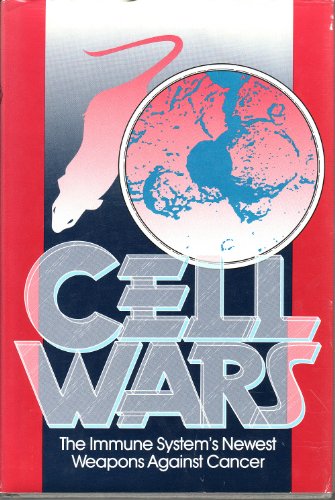Items related to Cell Wars: The Cancer-Killers of the Immune System

Synopsis
Charts the discovery of cancer-fighting monoclonal antibodies--the breakthrough technology enabling physicians to selectively destroy cancer cells--and explains how they are likely to affect cancer therapy in the future
"synopsis" may belong to another edition of this title.
From Publishers Weekly
The 1984 discovery by a Nobel Prize-winning cancer research team of Philadelphia's Wistar Institute of monoclonal antibodies permits identification of all parts of a cell too tiny to be seen even by an electron microscope. Goldberg, chief of endocrinology of Flint, Mich.'s Hurley Medical Center and also a novelist ( Nerve , etc.) here provides helpful background on the nature of the immune system and that of cancer-cell formation, along with a review of recent research and modes of treatment. The use of monoclonal antibodies as a diagnostic tool is invaluable and, in the case of cancer, helps to identify malignant cells. In addition, experimental cancer therapy by these antibodies used singly or in combination with other agents, is being conducted in several medical centers in an effort to reinforce the immune systems of patient volunteers, one of whose treatment of a pancreatic cancer employing Wistar Institute techniques the author recounts in moving detail. Although the patient did not survive, Goldberg stresses the scientific contribution and human benefits derived from the experiment.
Copyright 1988 Reed Business Information, Inc.
From Library Journal
Describing the case of a patient with pancreatic cancer, medical professor Goldberg explains the development of monoclonal antibody therapy and its application to several forms of cancer. His story concerns the Wistar Institute of Philadelphia, whose scientists developed this new therapy; Goldberg worked closely with them in its trial stages. His description of the institute and its scientists provides insight into their lives and ways of working, in a somewhat similar manner to Natalie Angier's Natural Obsessions ( LJ 8/88), and her description of Weinberg's laboratory at the Whitehead Institute of MIT. Clarity of explanation and an easy narrative style make this a good book for those interested in immunological cancer therapy. Eleanor Maass, Maass Assocs., Mew Milford, Pa.
Copyright 1988 Reed Business Information, Inc.
"About this title" may belong to another edition of this title.
- PublisherHill and Wang
- Publication date1988
- ISBN 10 0374120102
- ISBN 13 9780374120108
- BindingHardcover
- LanguageEnglish
- Edition number1
- Number of pages224
Shipping:
US$ 3.00
Within U.S.A.
Search results for Cell Wars: The Cancer-Killers of the Immune System
Cell Wars: The Cancer-Killers of the Immune System
Seller: Legacy Books LLC, Foley, AL, U.S.A.
hardcover. Condition: Good. Inscribed by author. Dustjacket has wear and tear. With possible toning, or mild soiling. Pages are clean and unmarked. If you have any questions, or would like images, please let me know. Seller Inventory # 241220038
Quantity: 1 available
Cell Wars: The Cancer-Killers of the Immune System
Seller: Robinson Street Books, IOBA, Binghamton, NY, U.S.A.
Hardcover. Condition: Very Good. Prompt Shipment, in Boxes, Tracking First Editions are First Printings. . Very good copy with clean pages and dust jacket. First edition. Seller Inventory # h5jd021
Quantity: 1 available
Cell Wars: The Cancer-Killers of the Immune System
Seller: Basement Seller 101, Cincinnati, OH, U.S.A.
Hardcover. Condition: As New. Seller Inventory # 140202008
Quantity: 1 available
Cell Wars: The Immune System's Newest Weapons Against Cancer
Seller: Antiquariat Jüterbook, Inh. H. Schulze, Jüterbog, Germany
Fester Einband. OPbd. im OSchU, unpag. 16x23,5cm, Leichte äußere Lagerspuren. . mangelhafter Zustand 476 gr. Seller Inventory # 000528
Quantity: 1 available
CELL WARS : THE IMMUNE SYSTEMS NEWEST WEAPONS AGAINST CANCER
Seller: Barclay Books, York, WA, Australia
HARDCOVER. 1988. First edition. A near fine copy only marked by a previous owners name to the front free endpaper. The d/w is unclipped and very good with edge wear. Seller Inventory # 7015917
Quantity: 1 available
Cell Wars: The Cancer-Killers of the Immune System
Seller: The Book Spot, Sioux Falls, MN, U.S.A.
Hardcover. Condition: New. Seller Inventory # Abebooks18102
Quantity: 1 available
CELL WARS The Cancer-Killers of the Immune System
Seller: Rare Book Cellar, Pomona, NY, U.S.A.
Hardcover. First Edition; First Printing. Very Good in a Very Good dust jacket. Stated First Edition. ; 1 x 9.1 x 6 Inches; 224 pages. Seller Inventory # 51934
Quantity: 1 available

